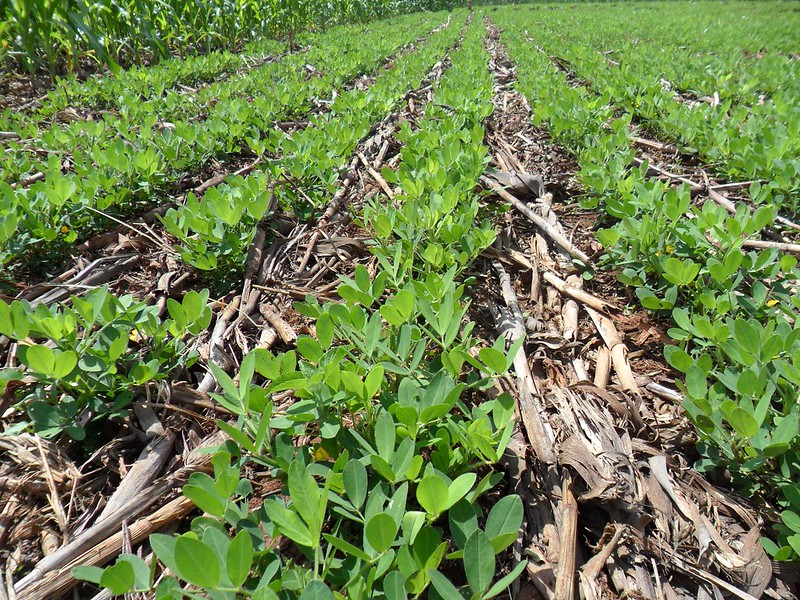Conservation Agriculture
Conservation agriculture involves practices that reduce soil disturbance, maintain soil cover, and diversify crop rotations. These methods enhance soil health, increase yields, and store soil carbon, contributing to climate change mitigation.

Examples of Conservation Agriculture include: no tillage, crop residue retention as mulch, and crop rotations. Work with your local Conservation District for assistance.
View open jobs in this Solution
Example Companies
- Regenerative Agriculture Alliance - Promotes regenerative agriculture practices to enhance soil health and biodiversity.
- General Mills - Implements regenerative agriculture practices across its supply chain.
- Rodale Institute - Conducts research and provides training on organic farming and conservation agriculture.
- Kiss the Ground - Advocates for regenerative agriculture to improve soil health and sequester carbon.
- Soil Health Institute - Focuses on advancing soil health through research and education.
Overview
Significant progress has been made in conservation agriculture for climate change reversal. Technologies developed include reducing tillage, increasing yields, and storing soil carbon, resulting in greenhouse gas emissions reduction.
Progress Made
Notable advancements in conservation agriculture for climate change include:
- No-Till Farming: Reducing soil disturbance to maintain soil structure and health.
- Cover Crops: Planting crops to cover the soil, preventing erosion and improving soil fertility.
- Crop Rotation: Alternating crops to improve soil health and reduce pest pressure.
Solutions by Sector
Agricultural Practices
- No-Till Farming: Reducing soil disturbance to maintain soil structure and health.
- Cover Crops: Planting crops to cover the soil, preventing erosion and improving soil fertility.
- Crop Rotation: Alternating crops to improve soil health and reduce pest pressure.
Case Studies:
- Rodale Institute, USA: Conducts research and provides training on organic farming and conservation agriculture (Rodale Institute).
- General Mills, USA: Implements regenerative agriculture practices across its supply chain (General Mills).
- Kiss the Ground, USA: Advocates for regenerative agriculture to improve soil health and sequester carbon (Kiss the Ground).
Soil Health
- Soil Testing: Regular testing to monitor soil health and nutrient levels.
- Organic Amendments: Using compost and manure to improve soil fertility.
- Microbial Inoculants: Introducing beneficial microbes to enhance soil health.
Case Studies:
- Soil Health Institute, USA: Focuses on advancing soil health through research and education (Soil Health Institute).
- Regenerative Agriculture Alliance, USA: Promotes regenerative agriculture practices to enhance soil health and biodiversity (Regenerative Agriculture Alliance).
- The Savory Institute, USA: Implements holistic management practices to improve soil health and ecosystem function (The Savory Institute).
Water Management
- Efficient Irrigation: Implementing drip irrigation and other water-saving technologies.
- Rainwater Harvesting: Collecting and storing rainwater for agricultural use.
- Contour Farming: Planting along the natural contours of the land to reduce soil erosion and water runoff.
Case Studies:
- NRCS, USA: Provides technical assistance and funding for water management practices (NRCS).
- The Land Institute, USA: Researches and promotes perennial crops and water-efficient farming practices (The Land Institute).
- World Agroforestry, Kenya: Implements water management practices in agroforestry systems (World Agroforestry).
Lessons Learned
- Farmer Involvement: Essential to involve farmers in the development and implementation process.
- Training and Support: Provide adequate training and support to farmers.
- Affordability and Accessibility: Ensure technology is affordable and accessible.
- Monitoring and Evaluation: Monitor and evaluate technology use for effectiveness and adjustments.
Challenges Ahead
- Global Adoption: Increase global adoption of conservation agriculture.
- Scaling Up: Scale up practices to meet farmer needs.
- Productivity: Enhance the productivity of conservation agriculture systems.
- Initial Investment: Address the initial investment barrier for many farmers.
- Short-Term Productivity Drop: Manage potential short-term productivity drops as soil recovers.
Best Path Forward
- Raise Awareness: Increase awareness of the benefits of conservation agriculture.
- Affordability: Make conservation agriculture practices more affordable and accessible.
- Technical Assistance: Provide technical assistance to farmers.
- Monitoring and Evaluation: Continuously monitor and evaluate practices for effectiveness.
- Policy Support: Advocate for policies that support conservation agriculture.
Image credit: Conservation District